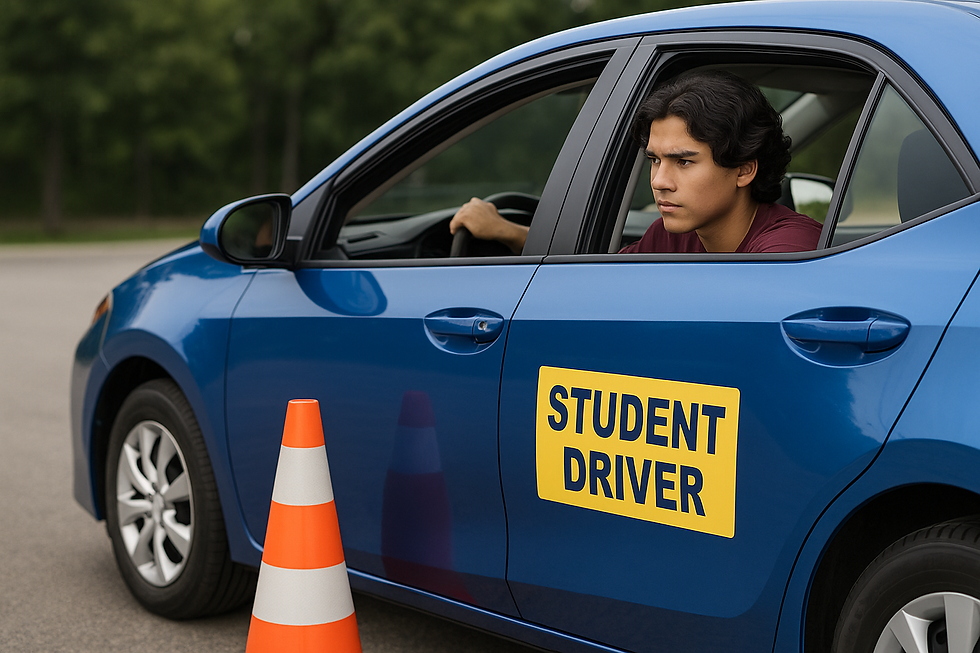Why So Many Students Fail the Road Test — and How to Avoid Their MistakesTL;DR:
- Travis Driving School
- Oct 24
- 4 min read
Updated: Nov 4
Many students fail their road test due to nerves, lack of preparation, or small avoidable errors.
Common reasons include poor observation, not signaling properly, speeding, and failing to yield.
Taking lessons with professional instructors like Travis Driving School increases your chances of passing.
Understanding what examiners look for and practicing under realistic conditions can make all the difference.
Learn key strategies to stay calm, confident, and test-ready.
Taking the road test is one of the most nerve-wracking experiences for new drivers. After hours of practice, studying, and anticipation, it all comes down to a short drive with an examiner who’s watching your every move. Unfortunately, many students fail not because they’re bad drivers—but because they make preventable mistakes.
At Travis Driving School, we’ve helped hundreds of students pass their road tests by focusing on proper preparation, skill development, and confidence building. In this guide, we’ll explore why so many students fail and, most importantly, how you can avoid the same mistakes.
The Most Common Reasons Students Fail the Road Test
1. Nerves Take Over

Test anxiety is one of the biggest reasons students fail their road test. Even confident drivers can freeze up when they see the examiner’s clipboard.
To overcome this:
Practice the exact test route (if possible) with a licensed instructor from Travis Driving School.
Simulate test conditions during practice—no talking, no music, and full focus.
Get plenty of rest the night before and arrive early to reduce stress.
2. Not Checking Mirrors and Blind Spots
Examiners pay close attention to your observation habits. Forgetting to check your mirrors or blind spots, even once, can cost you the test.
Always remember:
Check mirrors before every lane change, turn, or merge.
Look over your shoulder when switching lanes.
Scan intersections before proceeding.
3. Rolling Stops and Speeding
Rolling through a stop sign or failing to maintain proper speed limits are automatic fails. These are small but critical mistakes.
Pro Tip: During your lessons with Travis Driving School, instructors emphasize defensive driving techniques to help you develop safer habits that examiners love to see.
4. Poor Parking Skills
Parallel parking and backing into a space are two of the most commonly failed portions of the test.
Here’s how to improve:
Practice parking between cones or small markers in a safe area.
Use reference points (like mirrors or landmarks) to guide your turns.
Take it slow—speeding through parking maneuvers leads to errors.
5. Failing to Yield or Misunderstanding Right of Way
Many students hesitate or proceed too aggressively at intersections. Knowing when to go and when to wait is key.
At Travis Driving School, instructors dedicate time to teaching right-of-way rules with real-life scenarios, so students learn to make confident, lawful decisions.
How to Prepare for Success on Test Day
1. Take Professional Driving Lessons

Professional instructors know what examiners look for and can correct your mistakes before test day.
Travis Driving School offers personalized training sessions designed to help you master key test components like:
Parallel parking and backing-in
Proper lane changes and turning
Observation and communication habits
2. Review the Texas Driver Handbook The Texas Driver Handbook (available on the Texas Department of Public Safety website) outlines everything you need to know about traffic laws and test expectations. Make sure you’re familiar with:
Road signs and markings
Texas driving laws
Required documents for the test
3. Practice Defensive Driving
Defensive driving isn’t just for experienced drivers—it’s an essential skill for passing your road test.You can also take a Texas Defensive Driving Course online to strengthen your knowledge of safe driving practices.
4. Prepare Your Vehicle
Before your test:
Ensure brake lights, signals, and wipers are working.
Make sure the vehicle is clean and well-maintained.
Have your insurance and registration ready.
Examiners can cancel your test if your car isn’t roadworthy.
Staying Calm and Confident During the Test
1. Focus on What You Can Control
Don’t overthink every move. Concentrate on the basics—checking mirrors, signaling, and staying within speed limits.
2. Don’t Rush
If you make a small mistake, stay calm and continue driving safely. One minor slip-up won’t always mean failure.
3. Visualize Success
Before the test, take a few deep breaths and picture yourself driving smoothly and confidently.
At Travis Driving School, instructors teach visualization techniques to help students reduce anxiety and perform better under pressure.
After the Test — Pass or Fail
If you pass, congratulations! You’re ready to become a licensed driver in Texas. If not, don’t be discouraged. Most students who retake the test after taking extra lessons at Travis Driving School pass with flying colors.
Failing once doesn’t define your driving future—it just shows what you need to improve.
Conclusion — Drive Smart, Not Just Hard.

Passing your Texas road test isn’t just about memorizing rules—it’s about developing safe, confident habits behind the wheel. By understanding the most common mistakes and learning how to avoid them, you can drastically improve your chances of success.
At Travis Driving School, we specialize in helping students gain the skills and confidence they need to ace their test and become safe, responsible drivers. Don’t leave your success up to chance—book your driving lessons today and take the wheel toward your license!




Comments